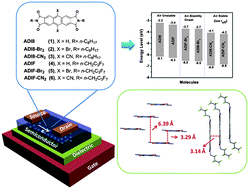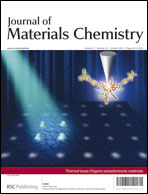A family of six n-channel organic semiconductors (1–6) based on the N,N′-dialkyl-2,3:6,7-anthracenedicarboximide (ADI) core was synthesized and characterized. These new semiconductors are functionalized with n-octyl (-n-C8H17), 1H,1H-perfluorobutyl (-n-CH2C3F7), cyano (–CN), and bromo (–Br) substituents, which results in wide HOMO and LUMO energy variations (∼1 eV) but negligible optical absorbance (λmax = 418–436 nm) in the visible region of the solar spectrum. Organic thin-film transistors (OTFTs) were fabricated via semiconductor vapor-deposition, and the resulting devices exhibit exclusively electron transport with good carrier mobilities (μe) of 10−3 to 0.06 cm2 V−1 s−1. Within this semiconductor family, cyano core-substitution plays a critical role in properly tuning the LUMO energy to enable good electron transport in ambient conditions while maintaining a low level of ambient doping (i.e., low Ioff). Core-cyanated ADIs 3 and 6 exhibit air-stable TFT device operation with electron mobilities up to 0.04 cm2 V−1 s−1 in air. Very high current on/off ratios of >107 are measured with positive threshold voltages (Vth = 5–15 V) and low off currents (Ioff = 10−9 to 10−12 A). Single-crystal structures of N,N′-1H,1H-perfluorobutyl ADIs 5 and 6 exhibit slipped-stack cofacial crystal packing with close π–π stacking distances of ∼3.2 Å. Additionally, close intermolecular interactions between imide-carbonyl oxygen and anthracene core-hydrogen are identified, which lead to the assembly of highly planar lamellar layers. Analysis of the air-stability of 1–6 thin films suggests that air-stability is mainly controlled by the LUMO energetics, and an electrochemical threshold of Ered1 = −0.3 to −0.4 V is estimated to stabilize n-channel transport in this family of materials.


 Please wait while we load your content...
Please wait while we load your content...